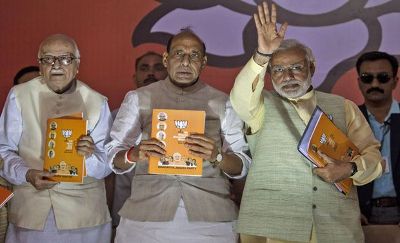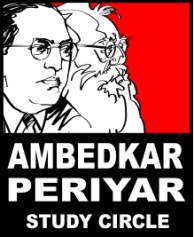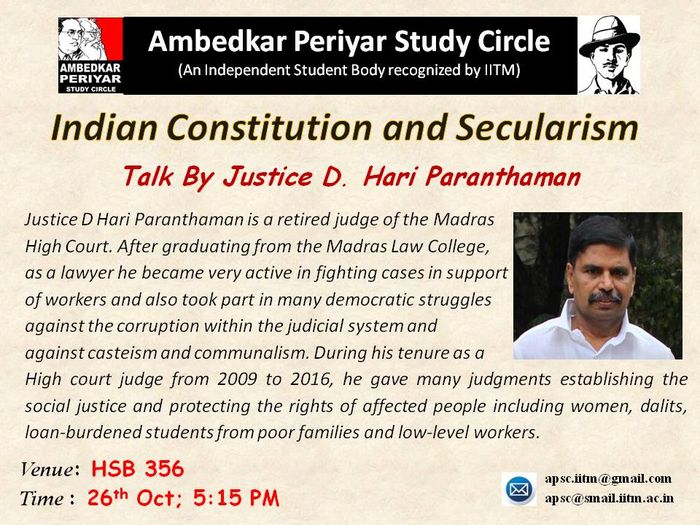Ambedkar-Periyar Study Circle
(An independent student body recognized by IITMadras)
Indian Constitution and Secularism
Every now and then we can hear the cry for “Uniform Civil Code” being raised by the Hindutva leaders. More recently they have re-initiated their propaganda about the need for uniform civil code. The hindutva forces give uniform civil code an importance equal to what they give for the Ayodhya issue, as they believe that it would take them to their goal of Hindu Rashtra. By targeting the polygamy and triple talaq practices of the Muslim men, they are trying to portray the Hindu personal law as more progressive.

“If India is a true secular state then why not bring a civil code that is common for all Indians” is the question put forth by the allies of Hindutva, and this is the question that their opponents always wish to skip from answering. Hence the Hindutva forces conclude that, this is pseudo-secularism and in fact this argument makes most of the ‘Hindus’ to think so. For this purpose they put forth a fraudulent description for secularism as “To treat all religions equally”. But the true meaning of secularism is “To forbid any religion from controlling the government, its administration and the civil society”.
The question here is whether the Indian constitution and the judiciary is truly secular? The answer for this question would eventually be ‘No’, if we take a look at the recent supreme court verdicts on most of the sensitive issues that took national attention. It has been proved in many occasions that the Articles 25 and 26 of the constitution that speaks about the Freedom of Religion, Religious Belief and Religious Institutions can be interpreted and used in favor of implementing “Sanatana Dharma” over the demands for social justice.
Ayodhya case is an apt case which shows, how these Articles in the Indian Constitution can be effectively used in favor of Hindutva Propaganda. Not only the 2010 Allahabad HC verdict that fixed the exact birth place of Ram at the disputed Ayodhya site, but also the previous verdicts in the same case by the lower courts were based on these Articles. The 1949 verdict that allowed entry to perform daily worship for the Idols that were placed inside the Mosque by the Hindu Nationalists, restrained Muslims from entering, based on the above secular Articles from the Indian Constitution. In 1992, when the Babri Masjid was demolished the Hindutva groups had in fact got permission for assembling near the disputed site on the pretext of performing bhajans. Permission for the so called bhajan on December 6 was in fact given by the supreme court, and this too was based on the Articles in Indian Constitution.
 Same is the case with Afzal Guru, as stated in the Supreme Court judgment, he was awarded capital punishment to satisfy the collective conscience of the society, though there was no direct evidence amounting to criminal conspiracy and all evidences against him were circumstantial. And the collective conscience of the society that was mentioned in the Supreme Court verdict is in fact the Hindu conscience that was crafted by the Hindutva propaganda and the Afzal Guru was hanged to satisfy this Hindu conscience.
Same is the case with Afzal Guru, as stated in the Supreme Court judgment, he was awarded capital punishment to satisfy the collective conscience of the society, though there was no direct evidence amounting to criminal conspiracy and all evidences against him were circumstantial. And the collective conscience of the society that was mentioned in the Supreme Court verdict is in fact the Hindu conscience that was crafted by the Hindutva propaganda and the Afzal Guru was hanged to satisfy this Hindu conscience.
Last year, a request by a bunch of Non-Brahmin, archaka students from Tamilnadu, to be appointed as temple priests was turned down by Supreme Court. The verdict in fact said Non-Brahmins can also be temple priests, but only if it is not against the Agamas. While media reports proclaimed that the supreme court has ordered in favor of the students, nobody bothered to point out that if such an appointment is made, then it can be easily proved that it is against Agamas and the appointment can be cancelled by vested Brahminical interests.
The Ram Sethu project was stalled with the court accepting Puranas as evidence against the scientific reasoning and the then DMK government of Tamilnadu faced the ire of Supreme Court for being rational. Same happened with the Chidambaram temple case where Article 26 was used to handover the temple and its properties to the corrupt Dikshitars who were actually looting this public property.
 Though the preamble to the Constitution of India states that it is secular, there is no clear definition for religion and secularism in the Indian Constitution and the Supreme Court’s definition for religion or religious beliefs in its judgments is a polar opposite to the true meaning of Secularism.
Though the preamble to the Constitution of India states that it is secular, there is no clear definition for religion and secularism in the Indian Constitution and the Supreme Court’s definition for religion or religious beliefs in its judgments is a polar opposite to the true meaning of Secularism.
We can cite many such cases, of different backgrounds, verdicts from different courts, but all the verdicts have one thing in common, the psychology that binds these verdicts comes from the Upper Caste Hindu Mentality. The Indian Constitution, the Indian Criminal Law and the Indian Penal Code all exists but in papers. It is the Hindu conscience that rules the heart of the Indian judiciary.
Indian Constitution and Secularism
Talk By Justice D. Hari Paranthaman
Justice D Hari Paranthaman is a retired judge of the Madras High Court. After graduating from the Madras Law College, as a lawyer he became very active in fighting cases in support of workers and also took part in many democratic struggles against the corruption within the judicial system and against casteism and communalism. During his tenure as High Court judges from 2009 to 2016, he gave many judgements establishing social justice and protecting the rights of oppressed people including women, dalits, loan-burdened students from poor families and low-level workers.
Venue : HSB 356
Time : 26th Oct, 5:15 pm
apsc.iitm@gmail.com
apsc@smail.iitm.ac.in



